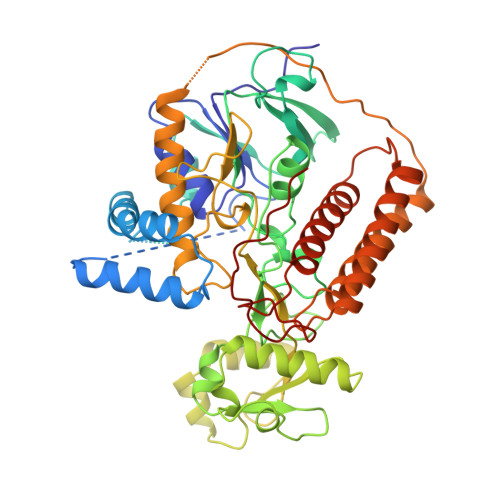Structure of L-aspartate oxidase: implications for the succinate dehydrogenase/fumarate reductase oxidoreductase family.
Mattevi, A., Tedeschi, G., Bacchella, L., Coda, A., Negri, A., Ronchi, S.(1999) Structure 7: 745-756
- PubMed: 10425677
- DOI: https://doi.org/10.1016/s0969-2126(99)80099-9
- Primary Citation of Related Structures:
1CHU - PubMed Abstract:
Given the vital role of NAD+ in cell metabolism, the enzymes involved in bacterial de novo NAD+ biosynthesis are possible targets for drug design against pathogenic bacteria. The first reaction in the pathway is catalysed by L-aspartate oxidase (LASPO), a flavoenzyme that converts aspartate to iminoaspartate using either molecular oxygen or fumarate as electron acceptors. LASPO has considerable sequence homology with the flavoprotein subunits of succinate dehydrogenase (SDH) and fumarate reductase (FRD). The crystal structure of the apoform of LASPO from Escherichia coli has been determined to 2.2 A resolution. The enzyme shows a novel fold for an FAD-dependent protein, comprising a three-domain structure: an FAD-binding domain with the dinucleotide-binding fold, a C-terminal three-helical bundle domain, and an alpha + beta capping domain, which is topologically similar to the small subunit of spinach ribulose-1,5-bisphosphate carboxylase/oxygenase. The interface between the FAD-binding and capping domains defines a cleft in which the active site is located. A number of strictly conserved residues present in all three domains indicate that LASPO, SDH and FRD share the same overall folding topology. Many of these conserved residues are in the FAD-binding site and active centre, suggesting a similar catalytic mechanism. Thus, LASPO, SDH and FRD form a class of functionally and structurally related oxidoreductases that are all able to reduce fumarate and to oxidise a dicarboxylate substrate.
- Dipartimento di Genetica e Microbiologia, Università di Pavia, Italy. mattevi@ipvgen.unipv.it
Organizational Affiliation:
















